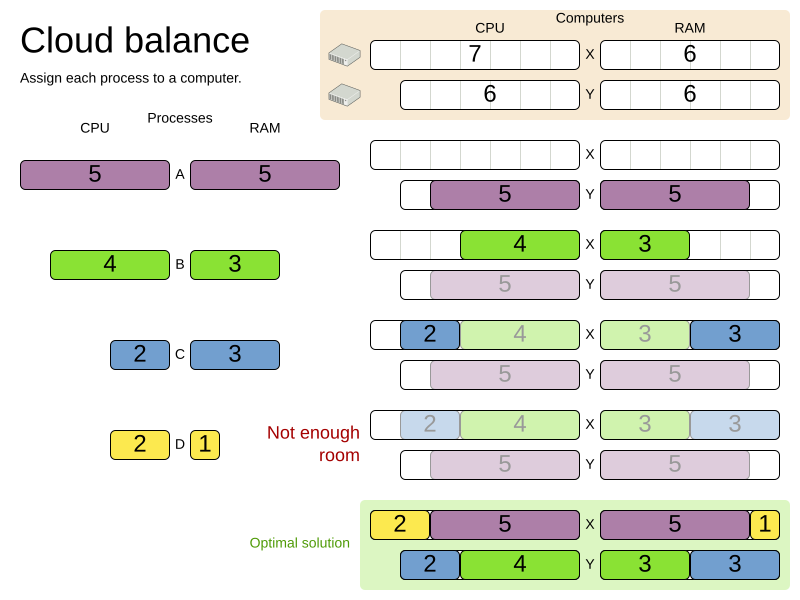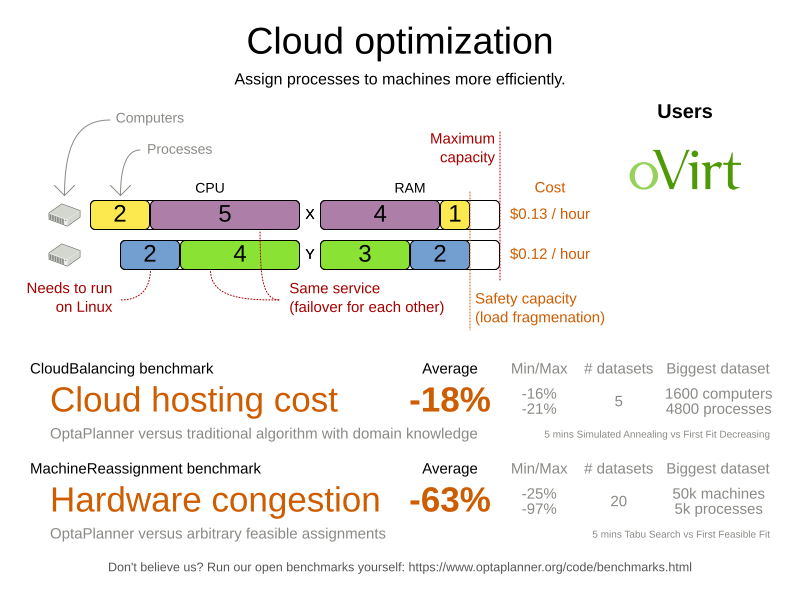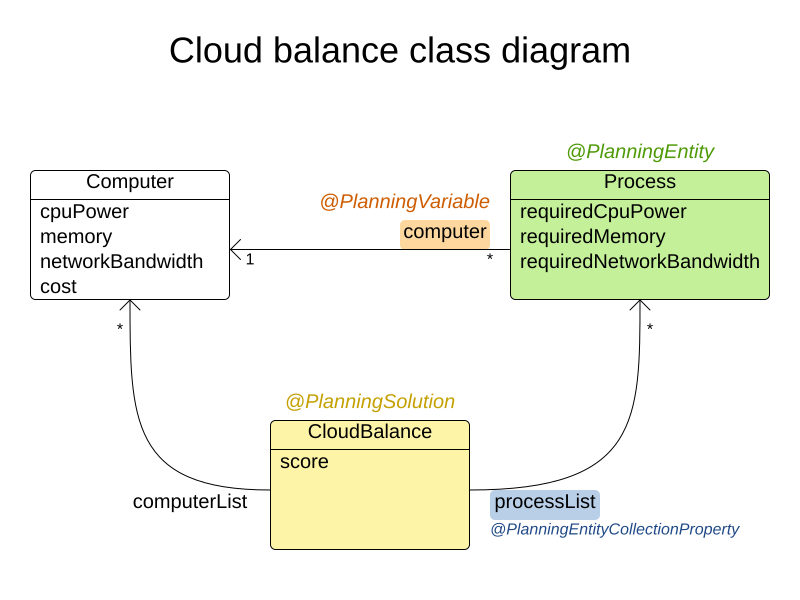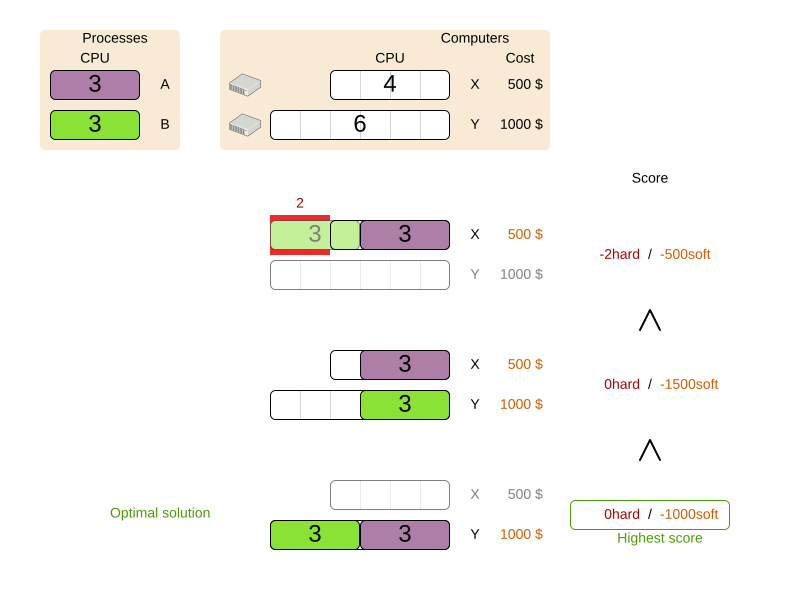Cloud balancing
Cloud balancing tutorial
Problem description
Suppose your company owns a number of cloud computers and needs to run a number of processes on those computers. Assign each process to a computer.
The following hard constraints must be fulfilled:
-
Every computer must be able to handle the minimum hardware requirements of the sum of its processes:
-
CPU capacity: The CPU power of a computer must be at least the sum of the CPU power required by the processes assigned to that computer.
-
Memory capacity: The RAM memory of a computer must be at least the sum of the RAM memory required by the processes assigned to that computer.
-
Network capacity: The network bandwidth of a computer must be at least the sum of the network bandwidth required by the processes assigned to that computer.
-
The following soft constraints should be optimized:
-
Each computer that has one or more processes assigned, incurs a maintenance cost (which is fixed per computer).
-
Cost: Minimize the total maintenance cost.
-
This problem is a form of bin packing. The following is a simplified example, in which we assign four processes to two computers with two constraints (CPU and RAM) with a simple algorithm:

The simple algorithm used here is the First Fit Decreasing algorithm, which assigns the bigger processes first and assigns the smaller processes to the remaining space.
As you can see, it is not optimal, as it does not leave enough room to assign the yellow process D.
OptaPlanner does find the more optimal solution by using additional, smarter algorithms. It also scales: both in data (more processes, more computers) and constraints (more hardware requirements, other constraints). So let’s see how OptaPlanner can be used in this scenario.
Here’s an executive summary of this example and an advanced implementation with more constraints:

Problem size
| Problem Size | Computers | Processes | Search Space |
|---|---|---|---|
2computers-6processes |
2 |
6 |
64 |
3computers-9processes |
3 |
9 |
10^4 |
4computers-12processes |
4 |
12 |
10^7 |
100computers-300processes |
100 |
300 |
10^600 |
200computers-600processes |
200 |
600 |
10^1380 |
400computers-1200processes |
400 |
1200 |
10^3122 |
800computers-2400processes |
800 |
2400 |
10^6967 |
Using the domain model
Domain model design
Using a domain model helps determine which classes are planning entities and which of their properties are planning variables. It also helps to simplify constraints, improve performance, and increase flexibility for future needs.
To create a domain model, define all the objects that represent the input data for the problem. In this simple example, the objects are processes and computers.
A separate object in the domain model must represent a full data set of problem, which contains the input data as well as a solution. In this example, this object holds a list of computers and a list of processes. Each process is assigned to a computer; the distribution of processes between computers is the solution.
-
Draw a class diagram of your domain model.
-
Normalize it to remove duplicate data.
-
Write down some sample instances for each class.
-
Computer: represents a computer with certain hardware and maintenance costs.In this example, the sample instances for the
Computerclass are:cpuPower,memory,networkBandwidth,cost. -
Process: represents a process with a demand. Needs to be assigned to aComputerby OptaPlanner.Sample instances for
Processare:requiredCpuPower,requiredMemory, andrequiredNetworkBandwidth. -
CloudBalance: represents a problem. Contains everyComputerandProcessfor a certain data set.For an object representing the full data set and solution, a sample instance holding the score must be present. OptaPlanner can calculate and compare the scores for different solutions; the solution with the highest score is the optimal solution. Therefore, the sample instance for
CloudBalanceisscore.
-
-
Determine which relationships (or fields) change during planning.
-
Planning entity: The class (or classes) that OptaPlanner can change during solving. In this example, it is the class
Process, because OptaPlanner can assign processes to computers. -
Problem fact: A class representing input data that OptaPlanner cannot change.
-
Planning variable: The property (or properties) of a planning entity class that changes during solving. In this example, it is the property
computeron the classProcess. -
Planning solution: The class that represents a solution to the problem. This class must represent the full data set and contain all planning entities. In this example that is the class
CloudBalance.
-
In the UML class diagram below, the OptaPlanner concepts are already annotated:

Domain model implementation
The Computer class
The Computer class is a POJO (Plain Old Java Object). Usually, you will have more of this kind of classes with input data.
public class CloudComputer ... {
private int cpuPower;
private int memory;
private int networkBandwidth;
private int cost;
... // getters
}The Process class
The Process class is particularly important. It is the class that is modified during solving.
We need to tell OptaPlanner that it can change the property computer. To do this:
. Annotate the class with @PlanningEntity.
. Annotate the getter getComputer() with @PlanningVariable.
Of course, the property computer needs a setter too, so OptaPlanner can change it during solving.
@PlanningEntity(...)
public class CloudProcess ... {
private int requiredCpuPower;
private int requiredMemory;
private int requiredNetworkBandwidth;
private CloudComputer computer;
... // getters
@PlanningVariable
public CloudComputer getComputer() {
return computer;
}
public void setComputer(CloudComputer computer) {
computer = computer;
}
// ************************************************************************
// Complex methods
// ************************************************************************
...
}-
OptaPlanner needs to know which values it can choose from to assign to the property
computer. Those values are retrieved from the methodCloudBalance.getComputerList()on the planning solution, which returns a list of all computers in the current data set. -
The
@PlanningVariableautomatically matches with the@ValueRangeProvideronCloudBalance.getComputerList().
|
Instead of getter annotations, it is also possible to use field annotations. |
The CloudBalance class
The CloudBalance class has a @PlanningSolution annotation.
-
It holds a list of all computers and a list of all processes.
-
It represents both the planning problem and (if it is initialized) the planning solution.
-
To save a solution, OptaPlanner initializes a new instance of the class.
-
The
processListproperty holds a list of processes. OptaPlanner can change the processes, allocating them to different computers. Therefore, a process is a planning entity and the list of processes is a collection of planning entities. We annotate the gettergetProcessList()with@PlanningEntityCollectionProperty. -
The
computerListproperty holds a list of computers. OptaPlanner cannot change the computers. Therefore, a computer is a problem fact. Especially for Constraint Streams, the propertycomputerListneeds to be annotated with a@ProblemFactCollectionPropertyso that OptaPlanner can retrieve the list of computers (problem facts) and make it available to the rule engine. -
The
CloudBalanceclass also has a@PlanningScoreannotated propertyscore, which is theScoreof that solution in its current state. OptaPlanner automatically updates it when it calculates aScorefor a solution instance. Therefore, this property needs a setter.
-
@PlanningSolution
public class CloudBalance ... {
private List<CloudComputer> computerList;
private List<CloudProcess> processList;
private HardSoftScore score;
@ValueRangeProvider
@ProblemFactCollectionProperty
public List<CloudComputer> getComputerList() {
return computerList;
}
@PlanningEntityCollectionProperty
public List<CloudProcess> getProcessList() {
return processList;
}
@PlanningScore
public HardSoftScore getScore() {
return score;
}
public void setScore(HardSoftScore score) {
this.score = score;
}
...
}Run the cloud balancing Hello World
-
Create a run configuration with the following main class:
org.optaplanner.examples.cloudbalancing.app.CloudBalancingHelloWorldBy default, the Cloud Balancing Hello World is configured to run for 120 seconds.
It executes the following code:
public class CloudBalancingHelloWorld {
public static void main(String[] args) {
// Build the Solver
SolverFactory<CloudBalance> solverFactory = SolverFactory.createFromXmlResource(
"org/optaplanner/examples/cloudbalancing/solver/cloudBalancingSolverConfig.xml");
Solver<CloudBalance> solver = solverFactory.buildSolver();
// Load a problem with 400 computers and 1200 processes
CloudBalance unsolvedCloudBalance = new CloudBalancingGenerator().createCloudBalance(400, 1200);
// Solve the problem
CloudBalance solvedCloudBalance = solver.solve(unsolvedCloudBalance);
// Display the result
System.out.println("\nSolved cloudBalance with 400 computers and 1200 processes:\n"
+ toDisplayString(solvedCloudBalance));
}
...
}The code example does the following:
-
Build the
Solverbased on a solver configuration which can come from an XML file as classpath resource:SolverFactory<CloudBalance> solverFactory = SolverFactory.createFromXmlResource( "org/optaplanner/examples/cloudbalancing/solver/cloudBalancingSolverConfig.xml"); Solver<CloudBalance> solver = solverFactory.buildSolver();Or to avoid XML, build it through the programmatic API instead:
SolverFactory<CloudBalance> solverFactory = SolverFactory.create(new SolverConfig() .withSolutionClass(CloudBalance.class) .withEntityClasses(CloudProcess.class) .withEasyScoreCalculatorClass(CloudBalancingEasyScoreCalculator.class) .withTerminationSpentLimit(Duration.ofMinutes(2))); Solver<CloudBalance> solver = solverFactory.buildSolver();The solver configuration is explained in the next section.
-
Load the problem.
CloudBalancingGeneratorgenerates a random problem: replace this with a class that loads a real problem, for example from a database.CloudBalance unsolvedCloudBalance = new CloudBalancingGenerator().createCloudBalance(400, 1200); -
Solve the problem.
CloudBalance solvedCloudBalance = solver.solve(unsolvedCloudBalance); -
Display the result.
System.out.println("\nSolved cloudBalance with 400 computers and 1200 processes:\n" + toDisplayString(solvedCloudBalance));
Solver configuration
The solver configuration file determines how the solving process works; it is considered a part of the code.
The file is named cloudBalancingSolverConfig.xml.
<?xml version="1.0" encoding="UTF-8"?>
<solver xmlns="https://www.optaplanner.org/xsd/solver" xmlns:xsi="http://www.w3.org/2001/XMLSchema-instance"
xsi:schemaLocation="https://www.optaplanner.org/xsd/solver https://www.optaplanner.org/xsd/solver/solver.xsd">
<!-- Domain model configuration -->
<solutionClass>org.optaplanner.examples.cloudbalancing.domain.CloudBalance</solutionClass>
<entityClass>org.optaplanner.examples.cloudbalancing.domain.CloudProcess</entityClass>
<!-- Score configuration -->
<scoreDirectorFactory>
<easyScoreCalculatorClass>org.optaplanner.examples.cloudbalancing.optional.score.CloudBalancingEasyScoreCalculator</easyScoreCalculatorClass>
<!--<constraintProviderClass>org.optaplanner.examples.cloudbalancing.score.CloudBalancingConstraintProvider</constraintProviderClass>-->
</scoreDirectorFactory>
<!-- Optimization algorithms configuration -->
<termination>
<secondsSpentLimit>30</secondsSpentLimit>
</termination>
</solver>This solver configuration consists of three parts:
-
Domain model configuration: What can OptaPlanner change?
We need to make OptaPlanner aware of our domain classes, annotated with
@PlanningEntityand@PlanningSolutionannotations:<solutionClass>org.optaplanner.examples.cloudbalancing.domain.CloudBalance</solutionClass> <entityClass>org.optaplanner.examples.cloudbalancing.domain.CloudProcess</entityClass> -
Score configuration: How should OptaPlanner optimize the planning variables? What is our goal?
Since we have hard and soft constraints, we use a
HardSoftScore. But we need to tell OptaPlanner how to calculate the score, depending on our business requirements. Further down, we will look into two alternatives to calculate the score, such as using an easy Java implementation, or Constraint Streams.<scoreDirectorFactory> <easyScoreCalculatorClass>org.optaplanner.examples.cloudbalancing.optional.score.CloudBalancingEasyScoreCalculator</easyScoreCalculatorClass> <!--<constraintProviderClass>org.optaplanner.examples.cloudbalancing.score.CloudBalancingConstraintProvider</constraintProviderClass>--> </scoreDirectorFactory> -
Optimization algorithms configuration: How should OptaPlanner optimize it?
In this case, we use the default optimization algorithms (because no explicit optimization algorithms are configured) for 30 seconds:
<termination> <secondsSpentLimit>30</secondsSpentLimit> </termination>OptaPlanner should get a good result in seconds (and even in less than 15 milliseconds with real-time planning), but the more time it has, the better the results. Advanced use cases might use different termination criteria than a hard time limit.
The default algorithms already easily surpass human planners and most in-house implementations. Use the Benchmarker to power tweak to get even better results.
Score configuration
OptaPlanner searches for the solution with the highest Score.
This example uses a HardSoftScore, which means OptaPlanner looks for the solution with no hard constraints broken (fulfill hardware requirements) and as little as possible soft constraints broken (minimize maintenance cost).

Of course, OptaPlanner needs to be told about these domain-specific score constraints. There are several ways to implement such a score function:
Easy Java score configuration
One way to define a score function is to implement the interface EasyScoreCalculator in plain Java.
<scoreDirectorFactory>
<easyScoreCalculatorClass>org.optaplanner.examples.cloudbalancing.optional.score.CloudBalancingEasyScoreCalculator</easyScoreCalculatorClass>
</scoreDirectorFactory>Just implement the calculateScore(Solution) method to return a HardSoftScore instance.
public class CloudBalancingEasyScoreCalculator
implements EasyScoreCalculator<CloudBalance, HardSoftScore> {
/**
* A very simple implementation. The double loop can easily be removed by using Maps as shown in
* {@link CloudBalancingMapBasedEasyScoreCalculator#calculateScore(CloudBalance)}.
*/
@Override
public HardSoftScore calculateScore(CloudBalance cloudBalance) {
int hardScore = 0;
int softScore = 0;
for (CloudComputer computer : cloudBalance.getComputerList()) {
int cpuPowerUsage = 0;
int memoryUsage = 0;
int networkBandwidthUsage = 0;
boolean used = false;
// Calculate usage
for (CloudProcess process : cloudBalance.getProcessList()) {
if (computer.equals(process.getComputer())) {
cpuPowerUsage += process.getRequiredCpuPower();
memoryUsage += process.getRequiredMemory();
networkBandwidthUsage += process.getRequiredNetworkBandwidth();
used = true;
}
}
// Hard constraints
int cpuPowerAvailable = computer.getCpuPower() - cpuPowerUsage;
if (cpuPowerAvailable < 0) {
hardScore += cpuPowerAvailable;
}
int memoryAvailable = computer.getMemory() - memoryUsage;
if (memoryAvailable < 0) {
hardScore += memoryAvailable;
}
int networkBandwidthAvailable = computer.getNetworkBandwidth() - networkBandwidthUsage;
if (networkBandwidthAvailable < 0) {
hardScore += networkBandwidthAvailable;
}
// Soft constraints
if (used) {
softScore -= computer.getCost();
}
}
return HardSoftScore.of(hardScore, softScore);
}
}Even if we optimize the code above to use Maps to iterate through the processList only once, it is still slow because it does not do incremental score calculation.
To fix that, either use constraint streams, incremental Java score calculation or Drools score calculation.
Constraint streams score configuration
Constraint Streams use incremental calculation.
To use it, implement the interface ConstraintProvider in Java.
<scoreDirectorFactory>
<constraintProviderClass>org.optaplanner.examples.cloudbalancing.score.CloudBalancingConstraintProvider</constraintProviderClass>
</scoreDirectorFactory>We want to make sure that all computers have enough CPU, RAM and network bandwidth to support all their processes, so we make these hard constraints. If those constraints are met, we want to minimize the maintenance cost, so we add that as a soft constraint.
public class CloudBalancingConstraintProvider implements ConstraintProvider {
@Override
public Constraint[] defineConstraints(ConstraintFactory constraintFactory) {
return new Constraint[] {
requiredCpuPowerTotal(constraintFactory),
requiredMemoryTotal(constraintFactory),
requiredNetworkBandwidthTotal(constraintFactory),
computerCost(constraintFactory)
};
}
Constraint requiredCpuPowerTotal(ConstraintFactory constraintFactory) {
return constraintFactory.forEach(CloudProcess.class)
.groupBy(CloudProcess::getComputer, sum(CloudProcess::getRequiredCpuPower))
.filter((computer, requiredCpuPower) -> requiredCpuPower > computer.getCpuPower())
.penalize(HardSoftScore.ONE_HARD,
(computer, requiredCpuPower) -> requiredCpuPower - computer.getCpuPower())
.asConstraint("requiredCpuPowerTotal");
}
Constraint requiredMemoryTotal(ConstraintFactory constraintFactory) {
return constraintFactory.forEach(CloudProcess.class)
.groupBy(CloudProcess::getComputer, sum(CloudProcess::getRequiredMemory))
.filter((computer, requiredMemory) -> requiredMemory > computer.getMemory())
.penalize(HardSoftScore.ONE_HARD,
(computer, requiredMemory) -> requiredMemory - computer.getMemory())
.asConstraint("requiredMemoryTotal");
}
Constraint requiredNetworkBandwidthTotal(ConstraintFactory constraintFactory) {
return constraintFactory.forEach(CloudProcess.class)
.groupBy(CloudProcess::getComputer, sum(CloudProcess::getRequiredNetworkBandwidth))
.filter((computer, requiredNetworkBandwidth) -> requiredNetworkBandwidth > computer.getNetworkBandwidth())
.penalize(HardSoftScore.ONE_HARD,
(computer, requiredNetworkBandwidth) -> requiredNetworkBandwidth - computer.getNetworkBandwidth())
.asConstraint("requiredNetworkBandwidthTotal");
}
Constraint computerCost(ConstraintFactory constraintFactory) {
return constraintFactory.forEach(CloudComputer.class)
.ifExists(CloudProcess.class, equal(Function.identity(), CloudProcess::getComputer))
.penalize(HardSoftScore.ONE_SOFT,
CloudComputer::getCost)
.asConstraint("computerCost");
}
}Incremental Java score configuration
Another way to define a score function is to implement the interface IncrementalScoreCalculator in plain Java.
<scoreDirectorFactory>
<easyScoreCalculatorClass>org.optaplanner.examples.cloudbalancing.optional.score.CloudBalancingIncrementalScoreCalculator</easyScoreCalculatorClass>
</scoreDirectorFactory>public class CloudBalancingIncrementalScoreCalculator
implements IncrementalScoreCalculator<CloudBalance, HardSoftScore> {
private Map<CloudComputer, Integer> cpuPowerUsageMap;
private Map<CloudComputer, Integer> memoryUsageMap;
private Map<CloudComputer, Integer> networkBandwidthUsageMap;
private Map<CloudComputer, Integer> processCountMap;
private int hardScore;
private int softScore;
@Override
public void resetWorkingSolution(CloudBalance cloudBalance) {
int computerListSize = cloudBalance.getComputerList().size();
cpuPowerUsageMap = new HashMap<>(computerListSize);
memoryUsageMap = new HashMap<>(computerListSize);
networkBandwidthUsageMap = new HashMap<>(computerListSize);
processCountMap = new HashMap<>(computerListSize);
for (CloudComputer computer : cloudBalance.getComputerList()) {
cpuPowerUsageMap.put(computer, 0);
memoryUsageMap.put(computer, 0);
networkBandwidthUsageMap.put(computer, 0);
processCountMap.put(computer, 0);
}
hardScore = 0;
softScore = 0;
for (CloudProcess process : cloudBalance.getProcessList()) {
insert(process);
}
}
@Override
public void beforeVariableChanged(Object entity, String variableName) {
retract((CloudProcess) entity);
}
@Override
public void afterVariableChanged(Object entity, String variableName) {
insert((CloudProcess) entity);
}
@Override
public void beforeEntityRemoved(Object entity) {
retract((CloudProcess) entity);
}
...
private void insert(CloudProcess process) {
CloudComputer computer = process.getComputer();
if (computer != null) {
int cpuPower = computer.getCpuPower();
int oldCpuPowerUsage = cpuPowerUsageMap.get(computer);
int oldCpuPowerAvailable = cpuPower - oldCpuPowerUsage;
int newCpuPowerUsage = oldCpuPowerUsage + process.getRequiredCpuPower();
int newCpuPowerAvailable = cpuPower - newCpuPowerUsage;
hardScore += Math.min(newCpuPowerAvailable, 0) - Math.min(oldCpuPowerAvailable, 0);
cpuPowerUsageMap.put(computer, newCpuPowerUsage);
int memory = computer.getMemory();
int oldMemoryUsage = memoryUsageMap.get(computer);
int oldMemoryAvailable = memory - oldMemoryUsage;
int newMemoryUsage = oldMemoryUsage + process.getRequiredMemory();
int newMemoryAvailable = memory - newMemoryUsage;
hardScore += Math.min(newMemoryAvailable, 0) - Math.min(oldMemoryAvailable, 0);
memoryUsageMap.put(computer, newMemoryUsage);
int networkBandwidth = computer.getNetworkBandwidth();
int oldNetworkBandwidthUsage = networkBandwidthUsageMap.get(computer);
int oldNetworkBandwidthAvailable = networkBandwidth - oldNetworkBandwidthUsage;
int newNetworkBandwidthUsage = oldNetworkBandwidthUsage + process.getRequiredNetworkBandwidth();
int newNetworkBandwidthAvailable = networkBandwidth - newNetworkBandwidthUsage;
hardScore += Math.min(newNetworkBandwidthAvailable, 0) - Math.min(oldNetworkBandwidthAvailable, 0);
networkBandwidthUsageMap.put(computer, newNetworkBandwidthUsage);
int oldProcessCount = processCountMap.get(computer);
if (oldProcessCount == 0) {
softScore -= computer.getCost();
}
int newProcessCount = oldProcessCount + 1;
processCountMap.put(computer, newProcessCount);
}
}
private void retract(CloudProcess process) {
CloudComputer computer = process.getComputer();
if (computer != null) {
int cpuPower = computer.getCpuPower();
int oldCpuPowerUsage = cpuPowerUsageMap.get(computer);
int oldCpuPowerAvailable = cpuPower - oldCpuPowerUsage;
int newCpuPowerUsage = oldCpuPowerUsage - process.getRequiredCpuPower();
int newCpuPowerAvailable = cpuPower - newCpuPowerUsage;
hardScore += Math.min(newCpuPowerAvailable, 0) - Math.min(oldCpuPowerAvailable, 0);
cpuPowerUsageMap.put(computer, newCpuPowerUsage);
int memory = computer.getMemory();
int oldMemoryUsage = memoryUsageMap.get(computer);
int oldMemoryAvailable = memory - oldMemoryUsage;
int newMemoryUsage = oldMemoryUsage - process.getRequiredMemory();
int newMemoryAvailable = memory - newMemoryUsage;
hardScore += Math.min(newMemoryAvailable, 0) - Math.min(oldMemoryAvailable, 0);
memoryUsageMap.put(computer, newMemoryUsage);
int networkBandwidth = computer.getNetworkBandwidth();
int oldNetworkBandwidthUsage = networkBandwidthUsageMap.get(computer);
int oldNetworkBandwidthAvailable = networkBandwidth - oldNetworkBandwidthUsage;
int newNetworkBandwidthUsage = oldNetworkBandwidthUsage - process.getRequiredNetworkBandwidth();
int newNetworkBandwidthAvailable = networkBandwidth - newNetworkBandwidthUsage;
hardScore += Math.min(newNetworkBandwidthAvailable, 0) - Math.min(oldNetworkBandwidthAvailable, 0);
networkBandwidthUsageMap.put(computer, newNetworkBandwidthUsage);
int oldProcessCount = processCountMap.get(computer);
int newProcessCount = oldProcessCount - 1;
if (newProcessCount == 0) {
softScore += computer.getCost();
}
processCountMap.put(computer, newProcessCount);
}
}
@Override
public HardSoftScore calculateScore() {
return HardSoftScore.of(hardScore, softScore);
}
}This score calculation is the fastest we can possibly make it. It reacts to every planning variable change, making the smallest possible adjustment to the score.
Beyond this tutorial
Now that this simple example works, you can try going further. For example, you can enrich the domain model and add extra constraints such as these:
-
Each
Processbelongs to aService. A computer might crash, so processes running the same service must be assigned to different computers. -
Each
Computeris located in aBuilding. A building might burn down, so processes of the same services should (or must) be assigned to computers in different buildings.